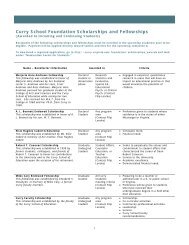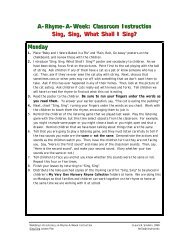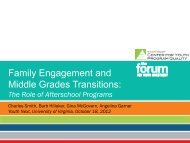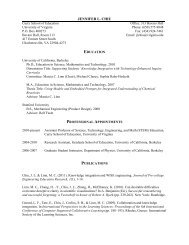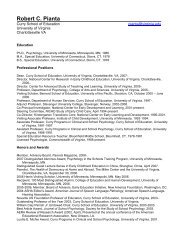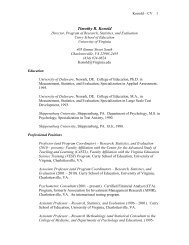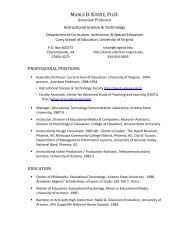The School Climate Bullying Survey - Curry School of Education
The School Climate Bullying Survey - Curry School of Education
The School Climate Bullying Survey - Curry School of Education
You also want an ePaper? Increase the reach of your titles
YUMPU automatically turns print PDFs into web optimized ePapers that Google loves.
Research Using the SCBS<br />
<strong>The</strong> SCBS was developed by Dewey Cornell, initially in collaboration with Peter Sheras and with ongoing<br />
assistance from their graduate students. <strong>The</strong> SCBS builds upon the seminal research on bullying conducted by<br />
Olweus (Olweus, 1993; Olweus & Limber, 2000) and other youth aggression researchers (e.g., Rigby 1996;<br />
Slaby & Guerra, 1988). <strong>The</strong>re have been changes in item content over the years in response to user feedback<br />
and research findings. <strong>The</strong> most recent version <strong>of</strong> the survey is presented here.<br />
McConville, D., & Cornell, D. (2003). Attitudes toward aggression and aggressive behavior among middle<br />
school students. Journal <strong>of</strong> Emotional and Behavioral Disorders, 11, 179-187.<br />
Are student attitudes toward peer aggression predictive <strong>of</strong> aggressive behavior in middle school? This<br />
prospective study found that self-reported attitudes toward peer aggression among 403 middle school<br />
students were both internally consistent (Cronbach’s alphas = .81 and .82) and stable over time (seven<br />
month test-retest r = .66). Most notably, aggressive attitudes were correlated with four outcome criteria for<br />
aggressive behavior: student self-report <strong>of</strong> peer aggression, peer and teacher nominations <strong>of</strong> bullying, and<br />
school discipline referrals. Significant correlations ranged from r = .09 to .37. Receiver operating<br />
characteristic analyses resulted in effect sizes ranging from .59 to .75. Overall, this study demonstrates that<br />
assessment <strong>of</strong> student attitudes toward aggression yields concurrent and predictive information related to a<br />
range <strong>of</strong> aggressive and disruptive behaviors in middle school.<br />
Cornell, D., & Brockenbrough, K. (2004). Identification <strong>of</strong> bullies and victims: A comparison <strong>of</strong> methods.<br />
Journal <strong>of</strong> <strong>School</strong> Violence, 3, 63-87.<br />
<strong>Bullying</strong> studies frequently rely on student self-report to identify bullies and victims <strong>of</strong> bullying, but<br />
research in the broader field <strong>of</strong> peer aggression makes greater use <strong>of</strong> other informants, especially peers, to<br />
identify aggressors and victims. This study compared self, peer, and teacher identification <strong>of</strong> bullies and<br />
bully victims in a sample <strong>of</strong> 416 middle school students. Overall, there was poor correspondence between<br />
self-reports and reports made by peers or teachers, but consistently better agreement between peers and<br />
teachers, in identifying both bullies and victims <strong>of</strong> bullying. Peer and teacher identification <strong>of</strong> bullies were<br />
more consistently associated with subsequent school disciplinary infractions than were self-reports. <strong>The</strong>se<br />
results raise concern about reliance on student self-reports <strong>of</strong> bullying and bully victimization.<br />
Cole, J., Cornell, D., & Sheras, P. (2006). Identification <strong>of</strong> school bullies by survey methods. Pr<strong>of</strong>essional<br />
<strong>School</strong> Counseling, 9, 305-313.<br />
How can middle school counselors identify bullies? This study compared two methods <strong>of</strong> identifying bullies<br />
in a sample <strong>of</strong> 386 middle school students. A peer nomination survey identified many more bullies than did<br />
student self-report. Moreover, self-reported and peer-nominated bullies differed in their types <strong>of</strong> bullying<br />
behaviors, level <strong>of</strong> general self-concept, attitudes toward aggression, and disciplinary infractions. Overall,<br />
this study raises concern about reliance on student self-report and supports the use <strong>of</strong> peer nomination as a<br />
means <strong>of</strong> identifying school bullies. <strong>The</strong>se findings have implications for school counselors in undertaking<br />
efforts to reduce school bullying.<br />
Williams, F., & Cornell, D. (2006). Student willingness to seek help for threats <strong>of</strong> violence. Journal <strong>of</strong> <strong>School</strong><br />
Violence, 5, 35-49.<br />
This study examined factors that influence a student’s willingness to seek help for a threat <strong>of</strong> violence. <strong>The</strong><br />
sample consisted <strong>of</strong> 542 middle school students who completed an anonymous survey that asked students<br />
how likely they would be to seek help in response to being bullied or threatened. <strong>The</strong> survey also included<br />
measures <strong>of</strong> type <strong>of</strong> bullying, attitudes toward aggressive behavior, and perceptions <strong>of</strong> teacher tolerance for<br />
8



